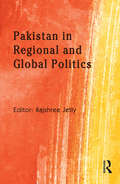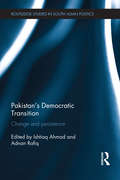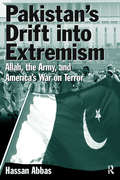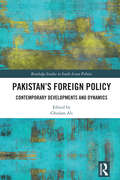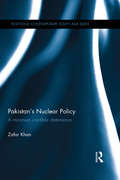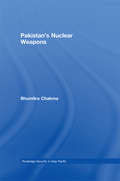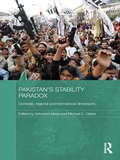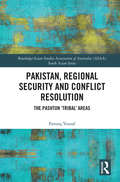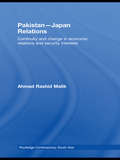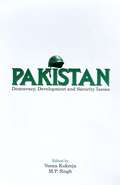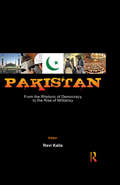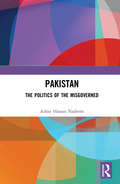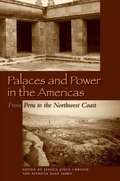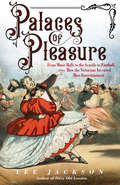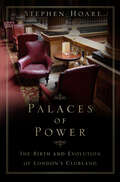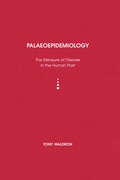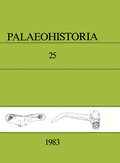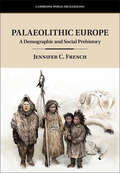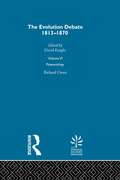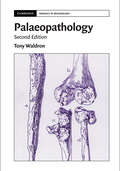- Table View
- List View
Pakistan Enigma Political Development: The Enigma Of Political Development (Short Histories Ser.)
by Lawrence ZiringThis volume was conceived to serve a variety of reader categories. It should meet the needs of teachers and students engaged in the study of Pakistan; it is hoped that it will offer area specialists an enlarged perspective from which to examine their own findings; and it ought to prove useful to the general reader who wishes to keep abreast of the forces and events shaping our time. Every effort has been made to define the essential themes, to provide the pertinent data, to analyze the significant events thoroughly, and to present the material in a lucid, fast-moving manner. Overall the book should be both informative and provocative. Given my long association with Pakistan,the many years spent investigating and experiencing its development, the unique opportunities I have enjoyed for personal contact with the country's passing leadership as well as its diverse population, I have taken liberties which less-involved scholars would no doubt avoid. I make no apologies for this somewhat personalized approach, or for the pointed comments that will be found throughout the volume. The Pakistan story does not lend itself to sterile description. It is an exciting and important chronicle and it ought to be presented in a fashion that stimulates debate in addition to making available the necessary facts. I trust I have succeeded in fulfilling both objectives.
Pakistan in Regional and Global Politics
by Rajshree JetlyPakistan is at currently at the centre of regional and global geo-strategic issues as a frontline state in the global war on terrorism. It is seeking to project itself as a modern Islamic state that can engage both the Islamic bloc and the western world in the post 9/11 era. This book addresses some questions under the broad rubric of International Relations and Security. It focuses on four themes: Pakistan and global security; Pakistan’s international relations; politics and identity in Pakistan; and economic development of Pakistan. Leading international experts have contributed articles within the framework of these themes.
Pakistan's Democratic Transition: Change and Persistence (Routledge Studies in South Asian Politics)
by Ishtiaq Ahmad and Adnan RafiqPolitics in Pakistan has traditionally been understood in the context of civil-military relationship. In May 2013, for the first time in history, Pakistan saw an elected government complete a full term in office and transfer power through the ballot box to another civilian government. In view of such an important development, this book offers critical perspectives on Pakistan’s current democratic transition and its implications for national politics, security and foreign policy. It critically analyses the emerging political trends in the country, including their underlying sources, attributes, constraints, and prospects of sustainability. Drawing on history, diverse theoretical perspectives, and empirical evidence, it explains the dynamics of the democratic process, contested borders and spaces, and regionalism. Contributions are from 13 prominent scholars in the field, who provide a wide-ranging analysis of Pakistan’s contemporary national and regional challenges, as well as the opportunities they entail for its viability as a democratic state. Taking the debate on Pakistan beyond the outmoded notions of praetorian politics and security, the book explores the future prospects of civilian supremacy in the country. It will be of interest to students and scholars of South Asian Politics, Political Sociology and Security Studies, as well as policy-makers, diplomats, security experts and military professionals.
Pakistan's Drift into Extremism: Allah, the Army, and America's War on Terror
by Hassan AbbasThis book examines the rise of religious extremism in Pakistan, particularly since 1947, and analyzes its connections to the Pakistani army's corporate interests and U.S.-Pakistan relations. It includes profiles of leading Pakistani militant groups with details of their origins, development, and capabilities. The author begins with an historical overview of the introduction of Islam to the Indian sub-continent in 712 AD, and brings the story up to the present by describing President Musharraf's handling of the war on terror. He provides a detailed account of the political developments in Pakistan since 1947 with a focus on the influence of religious and military forces. He also discusses regional politics, Pakistan's attempt to gain nuclear power status, and U.S.-Pakistan relations, and offers predictions for Pakistan's domestic and regional prospects.
Pakistan's Foreign Policy: Contemporary Developments and Dynamics (Routledge Studies in South Asian Politics)
by Ghulam AliThis book analyses Pakistan’s foreign policy and external relations with a focus on contemporary developments. It is structured in two parts – Foundation and Operationalization. The foundation provides a broad overview of Pakistan’s foreign policy and addresses specific foreign policy topics from a theoretical perspective such as foreign policy under Imran Khan, Pakistan’s middle power status and the role of military in influencing foreign policy decision making. The second part covers Pakistan’s relations with its all four neighbors (India, China, Afghanistan and Iran), with the US, Russia and EU. Based on in-depth interviews with Pakistani scholars, politicians and diplomats, the book offers a timely perspective on Pakistan’s foreign policy. The book will be of interest to academics working on Pakistan, South Asian Politics, Security and Conflict Studies, International Relations and Foreign Policy and Asian Studies.
Pakistan's Nuclear Policy: A Minimum Credible Deterrence (Routledge Contemporary South Asia Series)
by Zafar KhanIn May 1998, in reaction to India’s nuclear weapons tests, Pakistan tested six nuclear weapons. Following this, the country opted for a policy of minimum deterrence, and within a year Pakistan had altered its policy stance by adding the modifier of minimum ‘credible’ deterrence. This book looks at how this seemingly innocuous shift seriously impacted on Pakistan’s nuclear policy direction and whether the concept of minimum has lost its significance in the South Asian region’s changed/changing strategic environment. After providing a brief historical background exploring why and how Pakistan carried out the nuclear development program, the book questions why Pakistan could not sustain the minimum deterrence that it had conceptualized in the immediate aftermath of the 1998 test. It examines the conceptual theoretical framework of the essentials of minimum deterrence in order to question whether Pakistan’s nuclear policy remained consistent with this, as well as to discover the rudimentary factors that are responsible for the inconsistencies with regard to minimum deterrence conceived in this study. The book goes on to look at the policy options that Pakistan had after acquiring the nuclear capability, and what the rationale was for selecting minimum deterrence. The book not only highlights Pakistan deterrent force building, but also analyzes closely Pakistan’s doctrinal posture of first use option. Furthermore, it examines the policy towards arms control and disarmament, and discusses whether these individual policy orientations are consistent with the minimum deterrence. Conceptually providing a deeper understanding of Pakistan’s post-1998 nuclear policy, this book critically examines whether the minimum deterrence conceived could be sustained both at the theoretical and operational levels. It will be a useful contribution in the field of Nuclear Policy, Security Studies, Asian Politics, Proliferation/Non-Proliferation Studies, and Peace Studies. This book will be of interest to policy makers, scholars, and students of nuclear policy, nuclear proliferation and arms control related research.
Pakistan's Nuclear Weapons (Routledge Security in Asia Pacific Series)
by Bhumitra ChakmaPakistan is a vitally important country in the contemporary global political system. It is a de facto nuclear state, and a pivotal country in the War on Terror. This book provides a comprehensive study of a nuclear-armed Pakistan, investigating the implications of its emergence as a nuclear weapons state. Setting out the historical background of Pakistani nuclear development, the book examines the lessons for proliferation that can be drawn from the Pakistan case. It explains the changes and continuities of Pakistan’s nuclear policy, assessing its emerging force posture and the implications for Pakistani, South Asian and global security. It also considers the extent to which Pakistan can be said to have a nuclear doctrine, the Pakistani nuclear command and control system, and the relationship between Pakistan and the Non-Proliferation regime. Addressing the issue of whether Pakistan should be viewed as a proliferator, and the implications of a nuclear Pakistan for global terrorism, Pakistan’s Nuclear Weapons is an important study of all the major issues surrounding Pakistan’s emergence as a nuclear power.
Pakistan's Stability Paradox: Domestic, Regional and International Dimensions (Routledge Contemporary South Asia Series)
by Ashutosh Misra Michael E. ClarkePakistan, with the second largest Muslim population in the world, is a crucial country in the international system. It is an ally of the United States in the global ‘war on terror’ but is also regarded as a major bastion of some of the most active jihadist organisations. This book highlights and explores the paradoxes that characterise contemporary Pakistan from the simultaneous democratization and Islamization of civil society to the schizophrenic US-Pakistan relationship. The central theme of the book looks at Pakistan’s stability paradox. Commentators and analysts have over recent years often suggested that Pakistan was on the verge of state ‘failure’ or collapse resulting from a myriad of dilemmas. Yet, remarkably the Pakistani state has proven to be more resilient. This book identifies not only the factors that are contributing to Pakistan’s perceived instability but also those factors that have contributed to the state’s resilience. Chapters explore this central paradox through three core dimensions of Pakistan’s contemporary dilemmas – the domestic, regional and international dimensions.
Pakistan, Regional Security and Conflict Resolution: The Pashtun ‘Tribal’ Areas (Routledge/Asian Studies Association of Australia (ASAA) South Asian Series)
by Farooq YousafThis book explains how colonial legacies and the postcolonial state of Pakistan negatively influenced the socio-political and cultural dynamics and the security situation in Pakistan’s Pashtun ‘tribal’ areas, formerly known as the Federally Administered Tribal Areas (FATA). It offers a local perspective on peace and conflict resolution in Pakistan’s Pashtun ‘tribal’ region. Discussing the history and background of the former-FATA region, the role of Pashtun conflict resolution mechanism of Jirga, and the persistence of colonial-era Frontier Crimes Regulations (FCR) in the region, the author argues that the persistence of colonial legacies in the Pashtun ‘tribal’ areas, especially the FCR, coupled with the overarching influence of the military on security policy has negatively impacted the security situation in the region. By focusing on the Jirga and Jirga-based Lashkars (or Pashtun militias), the book demonstrates how Pashtuns have engaged in their own initiatives to handle the rise of militancy in their region. Moreover, the book contends that, even after the introduction of constitutional reforms and FATA’s merger with the Khyber Pakhtunkhwa province, little has changed in the region, especially regarding the treatment of ‘tribal’ Pashtuns as equal citizens of Pakistan. This book explains, in detail, why indigenous methods of peace and conflict resolution, such as the Jirga, could play "some" role towards long-term peace in the South Asian region. Historically and contextually informed with a focus on North-West Pakistan, this book will be of interest to academics researching South Asian Studies, International Relations, Peace and Conflict Studies, terrorism, and traditional justice and restorative forms of peace-making.
Pakistan-Japan Relations: Continuity and Change in Economic Relations and Security Interests (Routledge Contemporary South Asia Series)
by Ahmad Rashid MalikThis is the first book-length study to explain the complex nature of Pakistan-Japan relations. It analyses the evolution and development of relations between the two countries by defining two key factors: economic interests and security concerns in the US-led global security system. Providing a thorough analysis of the history of relations between the countries, the important role Pakistan played in the context of peace and conflict resolution in East Asia during 1947-52, which helped ending the Occupation of Japan and restoring the country’s post-war economy, is highlighted. Pakistan then emerged as the largest trading partner of Japan only after the United States. It was Pakistan’s benevolent role that helped Japan to comeback to Asia in the 1950s as the author explains these events in greater detail that are not commonly known. In the 1960s and also in the 1980s during the Soviet occupation of Afghanistan, Pakistan emerged as one of the largest recipients of Japanese aid. The author explains that Japanese strategic aid to Pakistan was diverted to strengthen democratic values and institutions after the end of the Cold War. He then clarifies that Pakistan-Japan relations were dominated by two main issues during the 1990s, Japanese economic cooperation in Pakistan's trade liberalization, and suspicion about Pakistan's nuclear program. In conclusion, the author states that there has been a remarkable continuity in the area of economic relations, though there have been changes in security concerns. The book sets out future prospects for economic and diplomatic relations between the two countries, and it will be of interest to academics working in the field of International Relations, International Political Economy, and Asian Studies. For intellectuals, diplomats, and businessmen, the book would be a handy reference.
Pakistan: Democracy, Development and Security Issues
by Veena Kukreja and M.P. SinghThis collection of essays takes a fresh look at the contentious themes of democracy, development and security in Pakistan today. Arguing that the three are closely interlinked, the editors posit that the political and economic experience of the past 58 years shows that neither democracy nor capitalist development can survive without the other. Using a variety of Pakistani, Indian and Western sources, the distinguished contributors examine the internal and external problems of Pakistan with an eye on the challenges that democracy has encountered in the country.
Pakistan: From The Rhetoric Of Democracy To The Rise Of Militancy
by Ravi KaliaThe essays in this volume address the central theme of Pakistan’s enduring, yet elusive, quest for democracy. The book charts Pakistan’s struggle from its very inception, at least in the political rhetoric provided by both civilian and military leaders, for democracy, liberalism, freedom of expression, inclusiveness of minorities and even secularism. At the same time, it demonstrates how in practice, the country has continued to drift towards increasingly brittle authoritarianism, religious extremism and intolerance of minorities — both Muslim and non-Muslim. This chasm between animated political rhetoric and grim political reality has baffled the world as much as Pakistanis themselves. In this volume, scholars and practitioners of statecraft from around the world have sought to explain the dichotomy that exists between the rhetoric and the reality. Crucial areas such as Pakistan’s troubled status as a theocracy; its relationship with the US; the position of women and their quest for empowerment; the Mujahir Qaumi movement; the sharp class divide that has led to an elitist political culture; and finally, an erudite discussion of the popular topic — Jinnah’s vision of Pakistan — are the focus of this book. This volume will be of interest to scholars of history, political science, international relations, sociology, anthropology and urban planning, policy-makers and think-tanks, as well as the wider reading public curious about South Asia.
Pakistan: The Politics of the Misgoverned
by Azhar Hassan NadeemThis book offers a comprehensive analysis of the state of political institutions, the military establishment and political parties in Pakistan. It provides a nuanced understanding of the practices of disenfranchisement by theocratic governments in the country which has relegated the people to the margins of their society. The volume provides an in-depth account of the political history of Pakistan focusing not only on national politics and foreign policy but also on their congruences with subnational systems of governance, the criminal justice system, bureaucracy, the electoral system and the police. It discusses challenging issues plaguing the country such as the continued dominance of the military, lagging economic development, lack of accountability within political institutions, sectarianism and terrorism. The author dissects and critically examines Pakistan’s hegemonic politics and underlines the need for a new social contract based on the principles of inclusiveness and equality. The volume offers fresh perspectives on the multifaceted problems in Pakistan’s politics. It will be of great interest to policy practitioners and to academics and students of politics, law and governance, sociology, international relations, comparative politics, Pakistan studies and South Asia studies.
Pakistan’s National Security Approach and Post-Cold War Security: Uneasy Co-existence (Routledge Studies in South Asian Politics)
by Arshad AliThis book analyzes the paradox that despite being a national security state, Pakistan has become even more insecure in the post-Cold War era. It provides an in-depth analysis of Pakistan’s foreign and security policies and their implications for the overall state and society. The book identifies the immediate security challenges to Pakistan and charts the distinctive evolution of Pakistan’s national security state in which the military elite became the dominant actor in the political sphere of government during and after the Cold War period. By examining the national security state, militarization, democracy and security, proxy wars and the hyper-military-industrial complex, the author illustrates how the vanguard role of the military created considerable structural, sociopolitical, economic, and security problems in Pakistan. Furthermore, the author argues that the mismatch between Pakistan’s national security stance and the transformed security environment has been facilitated and sustained by the embedded interests of the country’s military-industrial complex. A critical evaluation of the role of the military in the political affairs of the government and how it has created structural problems for Pakistan, this book will be of interest to academics in the field of South Asian Politics and Security, South Asian Foreign and Security Policy, International Relations, Asian Security, and Cold War Studies.
Pakistan’s Security and the India–US Strategic Partnership: Nuclear Politics and Security Competition (Routledge Studies in South Asian Politics)
by Syed Shahid BukhariThis book explores the relationship between the developing India–US strategic Partnership and Pakistan’s security. It assesses India and the US's areas of cooperation to show that the partnership will bring drastic changes for India’s military capabilities and modernization of its forces. The book shows that, in addition to enhancing India’s domestic nuclear stockpiles through the nuclear cooperation agreement, collaboration in high-tech areas such as space and innovative technologies will enable India to acquire sophisticated delivery systems as well as surveillance capacity. The author argues that these advancements will enable India to destabilize the strategic balance in the region. The book also briefly explores the nuclear doctrines of India and Pakistan that provide an insight into the role of nuclear weapons in maintaining deterrence in the region. To understand the power dynamics caused by the strategic partnership and their impact on strategic stability in South Asia, the author utilizes the Balance of Power and Power Transition theories. A timely analysis of the India–US Strategic Partnership with a Pakistan angle, the book will be of interest to academics working in the fields of Asian security, Asian politics, especially South Asia, strategic studies, international relations, political science, nuclear non-proliferation, conflict studies, arms control, and security studies.
Palace Politics
by Jonathan SchleferBringing rare interviews and meticulous research to the cloaked world of Mexican politics in the mid-twentieth century, Palace Politics provides a captivating look at the authoritarian Mexican state--one of the longest-lived regimes of its kind in recent history--as well as the origins of political instability itself, with revelations that can be applied to a variety of contemporary political situations around the globe. Culling a trove of remarkable firsthand accounts from former Mexican presidents, finance ministers, interior ministers, and other high officials from the 1950s through the 1980s, Jonathan Schlefer describes a world in which elite politics planted the seeds of a mammoth socioeconomic crisis. Palace Politics outlines the process by which political infighting among small rival factions of high officials drove Mexico to precarious situations at all levels of government. Schlefer also demonstrates how, earlier on, elite cooperation among these factions had helped sustain one of the most stable growth economies in Latin America, until all-or-nothing struggles began to tear the Mexican ruling party apart in the 1970s. A vivid, seamlessly narrated history, Palace Politics is essential reading for anyone seeking to better understand not only the nation next door but also the workings of elite politics in general.
Palaces and Power in the Americas: From Peru to the Northwest Coast
by Jessica Joyce Christie Patricia Joan SarroAncient American palaces still captivate those who stand before them. Even in their fallen and ruined condition, the palaces project such power that, according to the editors of this new collection, it must have been deliberately drawn into their formal designs, spatial layouts, and choice of locations. Such messages separated palaces from other elite architecture and reinforced the power and privilege of those residing in them. Indeed, as Christie and Sarro write, "the relation between political power and architecture is a pervasive and intriguing theme in the Americas. " Given the variety of cultures, time periods, and geographical locations examined within, the editors of this book have grouped the articles into four sections. The first looks at palaces in cultures where they have not previously been identified, including the Huaca of Moche Site, the Wari of Peru, and Chaco Canyon in the U. S. Southwest. The second section discusses palaces as "stage sets" that express power, such as those found among the Maya, among the Coast Salish of the Pacific Northwest, and at El Tajín on the Mexican Gulf Coast. The third part of the volume presents cases in which differences in elite residences imply differences in social status, with examples from Pasado de la Amada, the Valley of Oaxaca, Teotihuacan, and the Aztecs. The final section compares architectural strategies between cultures; the models here are Farfán, Peru, under both the Chimú and the Inka, and the separate states of the Maya and the Inka. Such scope, and the quality of the scholarship, make Palaces and Power in the Americas a must-have work on the subject.
Palaces of Pleasure: From Music Halls to the Seaside to Football, How the Victorians Invented Mass Entertainment
by Lee JacksonAn energetic and exhilarating account of the Victorian entertainment industry, its extraordinary success and enduring impact The Victorians invented mass entertainment. As the nineteenth century’s growing industrialized class acquired the funds and the free time to pursue leisure activities, their every whim was satisfied by entrepreneurs building new venues for popular amusement. Contrary to their reputation as dour, buttoned-up prudes, the Victorians reveled in these newly created ‘palaces of pleasure’. In this vivid, captivating book, Lee Jackson charts the rise of well-known institutions such as gin palaces, music halls, seaside resorts and football clubs, as well as the more peculiar attractions of the pleasure garden and international exposition, ranging from parachuting monkeys and human zoos to theme park thrill rides. He explores how vibrant mass entertainment came to dominate leisure time and how the attempts of religious groups and secular improvers to curb ‘immorality’ in the pub, variety theater and dance hall faltered in the face of commercial success. The Victorians’ unbounded love of leisure created a nationally significant and influential economic force: the modern entertainment industry.
Palaces of Power: The Birth and Evolution of London's Clubland
by Stephen Hoare‘A tour of gentleman’s clubs from their rowdy beginnings to their stately present’ The Times‘This book vividly captures clubland’s brief history in all its transient (and occasionally squalid) glory’ Daily Mail‘Stephen Hoare’s genial history of this Clubland-at-home is a fascinating story told with wit and verve’ Professor Jerry White, Birbeck University of LondonThe core of what we call St James’s dates from the late seventeenth century, when large estates were leased by the Crown to the landed gentry after the Restoration in 1660. St James’s clubs, coffee houses and institutions have been shaped by enterprise, political conflict and Britain’s emerging role as an Imperial power. This is the historic heart of London’s Clubland.Over 300 years, Clubland has extended its reach to encompass Piccadilly, Mayfair, Bond Street, Covent Garden and Westminster. Ever discreet, the clubs do not draw attention to themselves, though their members are often highly influential individuals who are leaders in politics, the law, the media and much more.Palaces of Power charts the evolution of London’s Clubland, St James’s, exploring the social and cultural history of the city’s most prestigious district, and studying the tensions between the world of privilege and an emerging public realm over the last three centuries.
Palaeoepidemiology: The Measure of Disease in the Human Past (UCL Institute of Archaeology Publications)
by Tony WaldronHow do we identify and measure human disease in the past? In the absence of soft tissue, paleoepidemiologists have developed ingenious ways of assessing illness and mortality in archaeological populations. In this volume, the key methods of epidemiology are outlined for non-specialists, showing the importance of studying prevalence over incidence, adjustments needed in studying past groups, how to compare studies, and the dangers of assessing occupation based upon bone evidence. A model for planning a proper paleoepidemiological study concludes the volume. Both as an introduction to epidemiology for archaeologists, and as a primer on archaeological analysis for epidemiologists, this book should serve the needs of both populations.
Palaeohistoria 25 (1983): Institute of Archaeology, Groningen, the Netherlands
by Institute of ArchaeologyThis volume gives an impression of the Archaeozoology Department's current research activity. It will be useful for several research workers, a number of technical assistants, and research students of archaeozoology.
Palaeohistoria: Institute of Archaeology, Groningen, the Netherlands
by Institute of ArchaeologyThis book includes a collection of papers, dedicated to Tjalling Waterbolk, on various topics, including palaeobotanical and archaeological research, prehistoric settlement in the province of Drenthe and the coastal areas of Groningen and Friesland, and radiocarbon dating of archaeological samples.
Palaeolithic Europe: A Demographic and Social Prehistory (Cambridge World Archaeology)
by Jennifer C. FrenchIn this book, Jennifer French presents a new synthesis of the archaeological, palaeoanthropological, and palaeogenetic records of the European Palaeolithic, adopting a unique demographic perspective on these first two-million years of European prehistory. Unlike prevailing narratives of demographic stasis, she emphasises the dynamism of Palaeolithic populations of both our evolutionary ancestors and members of our own species across four demographic stages, within a context of substantial Pleistocene climatic changes. Integrating evolutionary theory with a socially oriented approach to the Palaeolithic, French bridges biological and cultural factors, with a focus on women and children as the drivers of population change. She shows how, within the physiological constraints on fertility and mortality, social relationships provide the key to enduring demographic success. Through its demographic focus, French combines a 'big picture' perspective on human evolution with careful analysis of the day-to-day realities of European Palaeolithic hunter-gatherer communities—their families, their children, and their lives.
Palaeontology, 1860
by Richard OwenOwen was the founder of the Natural History Museum, bringing the collections over from the British Museum. Although he was a supporter of evolutionary theory, he was reluctant to accept Darwin's version of evolution. This volume examines fossil evidence for change in species over time.
Palaeopathology (Cambridge Manuals in Archaeology)
by Tony WaldronPalaeopathology is an evidence-based guide to the principal types of pathological lesions often found in human remains and how to diagnose them. Tony Waldron presents an innovative method of arriving at a diagnosis in the skeleton by applying what he refers to as 'operational definitions'. The method ensures that those who study bones will use the same criteria for diagnosing disease, thereby enabling valid comparisons to be made between studies. Waldron's book is based on modern clinical knowledge and provides background information on the natural history of bone disease. In addition, the volume demonstrates how results from studies should be analysed, methods of determining the frequency of disease, and other types of epidemiological analysis. This edition includes new chapters on the development of palaeopathology, basic concepts, health and disease, diagnosis, and spinal pathology. Chapters on analysis and interpretation have been thoroughly revised and enlarged.

